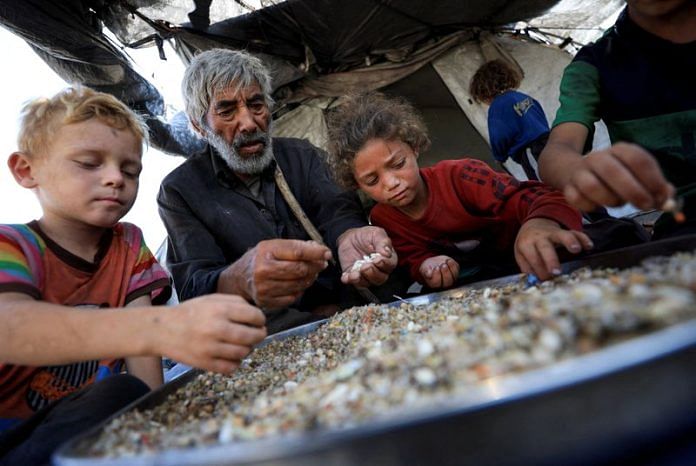By Olivia Le Poidevin and Jennifer Rigby
GENEVA (Reuters) -A global hunger monitor said on Tuesday that a famine scenario was unfolding in the Gaza Strip, with malnutrition soaring, children under five dying of hunger-related causes and humanitarian access severely restricted.
We examine what needs to be done to reverse the crisis.
WHAT IS BEING SENT IN AND HOW?
Israel said on Sunday it would halt military operations for 10 hours a day in parts of Gaza and designate secure routes for convoys delivering food and medicine between 6 a.m. and 11 p.m.
The U.N. agency for Palestinian refugees, UNRWA, says 500-600 trucks a day are needed to prevent more of the 2.1 million population people starving.
Since the announcement, over 100 truckloads of aid have been transported into Gaza, according to the U.N.
The World Food Program said that only half of the 100 trucks it hoped to get in daily had been allowed in, and it had not been able to reopen the lifeline bakeries and community kitchens that closed in May due to shortages.
TREATING ACUTE MALNUTRITION
More than 20,000 children were admitted to hospital with severe malnutrition between April and mid-July, according to the hunger monitor, Integrated Food Security Phase Classification (IPC).
The U.N. children’s charity UNICEF is focusing on urgent delivery of Ready-To-Use-Therapeutic-Foods, including dense peanut paste and high-energy biscuits, which the acutely malnourished require before they can start eating normal food.
Babies under six months need a therapeutic formula that works similarly to the paste.
UNICEF says these special foods are set to run out by mid-August.
Malnourished children often suffer complications that require antibiotics – something else that the WHO says is running out.
Acutely malnourished children can usually recover within 8-10 weeks, experts say. For children under 2, who may have been malnourished during critical brain development, full recovery is harder to achieve.
In all cases, long-term access to nutritious foods such as fruit, vegetables and meat is essential for full recovery, requiring commercial supplies to resume, UNICEF says.
AID BOXES AND AIRDROPS
The Gaza Humanitarian Foundation (GHF), a private U.S.- and Israeli-backed group, said it has distributed over 96 million meals since late May, in boxes of staples such as rice, flour, pasta, tuna, beans, biscuits and cooking oil.
However, most of these need to be cooked, and the IPC report noted that clean water and fuel are largely unavailable in Gaza.
Israel says it will allow airdrops of food, and Jordan and the United Arab Emirates parachuted 25 tons into Gaza on Sunday.
Yet it is widely acknowledged that the only effective way to meet Gaza’s needs is by truck. Airdrops are many times more expensive and UNICEF notes they feed the first to arrive, not those in most need.
DANGERS IN DISTRIBUTION
Ways must be found to get aid safely to the right recipients.
U.N. data gathered between May 19, when Israel lifted its blockade, and July 25 shows that only about one in eight of the 2,010 truckloads of relief collected from crossing points under the U.N.-led aid operation reached its destination.
The rest were looted, “either peacefully by hungry people or forcefully by armed actors during transit”.
An internal U.S. government analysis found no evidence of systematic theft by the Palestinian militant group Hamas of U.S.-funded humanitarian supplies, and the U.N. refuses to cooperate with GHF, Israel’s chosen aid provider. But deliveries by the GHF have, if anything, been more dangerous.
The U.N. estimates that Israeli forces have killed more than 1,000 people seeking food supplies, most of them near the militarised distribution sites of the GHF, which employs a U.S. logistics firm run by a former CIA officer and armed U.S. veterans.
GHF denies that there have been deadly incidents at its sites, and says the deadliest have been near other aid convoys.
The Israeli military has acknowledged that civilians have been harmed by its gunfire near distribution centres, and says its forces have now received better instructions.
(Reporting by Olivia Le Poidevin in Geneva and Jennifer Rigby in London; additional reporting by Michelle Nichols in New York and Nidal Al Mughrabi in Cairo; edited by Tom Perry in Beirut and Kevin Liffey)
Disclaimer: This report is auto generated from the Reuters news service. ThePrint holds no responsibility for its content.




